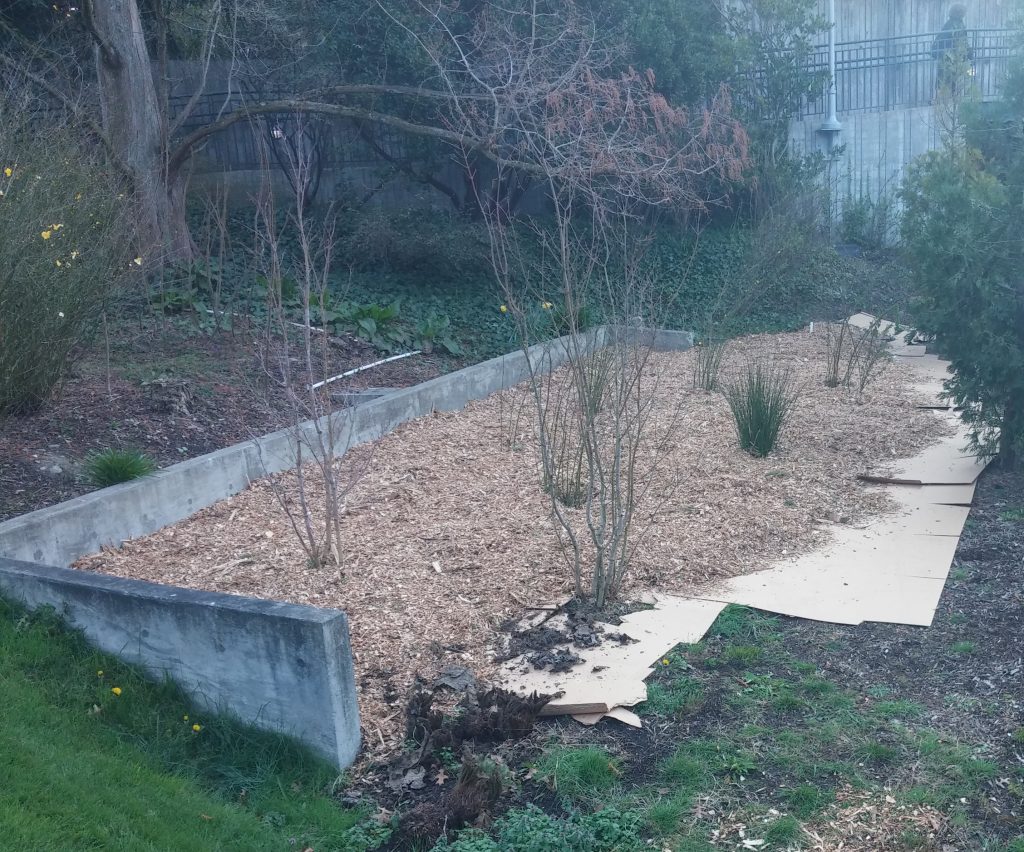
Cardboard used in landscape restoration 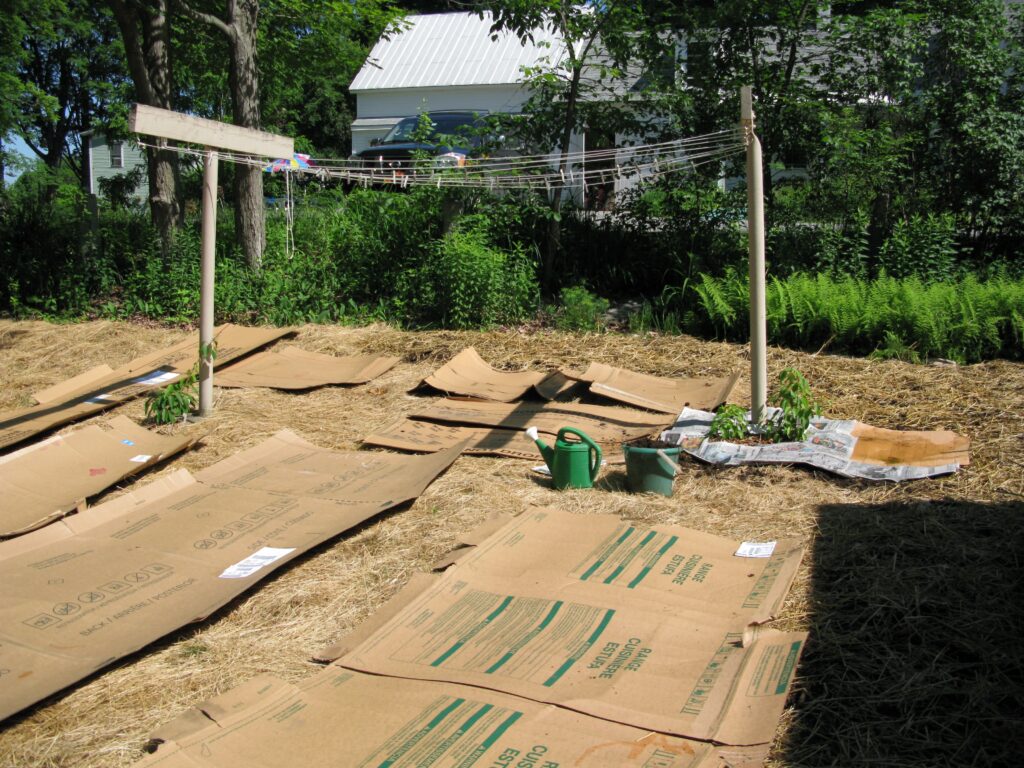
Cardboard used in lasagna gardening 
Cardboard used for weed control
In the quarter century that I’ve been researching, publishing, and educating on the topic of landscape mulches, one thing has become clear: cardboard should never be used as a mulch. This viewpoint has been of great interest to gardeners; in fact, my earlier post has been the most frequently viewed post since it was published in 2015. I occasionally appended new information to the original post as needed, but the topic deserves an update.

Rather than rehashing what’s been written earlier (which can be found here, here, here, here, and here in addition to the link above), I’m providing information in a Q&A format that might be helpful:
Q: Is there research on using cardboard mulch in home landscapes?
A: Not much. To date, the only peer-reviewed research relevant to landscape soil conditions is our own work published in 2019. The abstract explains the importance of the results to landscape soil health as stated in the abstract (below):
“The orders of magnitude differences in diffusion coefficients among the mulch materials, however, could negatively impact a diverse soil environment such as those found in biologically rich landscapes with higher oxygen demands. Among the mulches tested, wood chips are a preferred method of mulching in terms of providing best gas permeability, particularly in landscape conditions.”
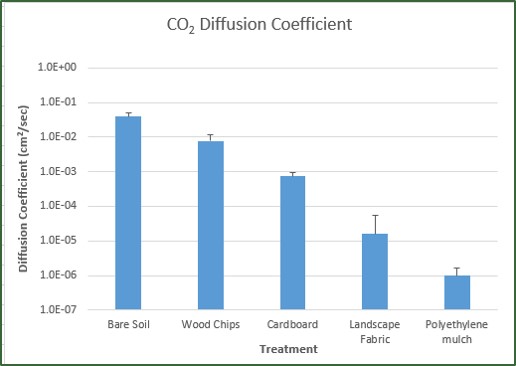
Q: Cardboard has been used as a mulch in agricultural production. Why doesn’t that research support using it in landscapes?

A: The goal in agricultural production is to maximize yield of an annual crop. In contrast, the goal in caring for a permanent landscape is to maintain a healthy soil ecosystem that will support plant life long term. The table below explains these differences in more detail.

Q: Okay, I understand that science doesn’t support using cardboard as a landscape mulch, but what about my vegetable garden? Isn’t the research on agricultural crops relevant there?
A: The research on agricultural production mulches is more relevant if maximizing yield is your most important goal. But your goals may include maintaining a healthy soil ecosystem, reducing the use of pesticides and fertilizers, and other criteria. Are you concerned about the established negative impacts that cardboard and other sheet mulches have on soil life? If so, then sheet mulches are not a good choice compared to chunky, three-dimensional mulches.
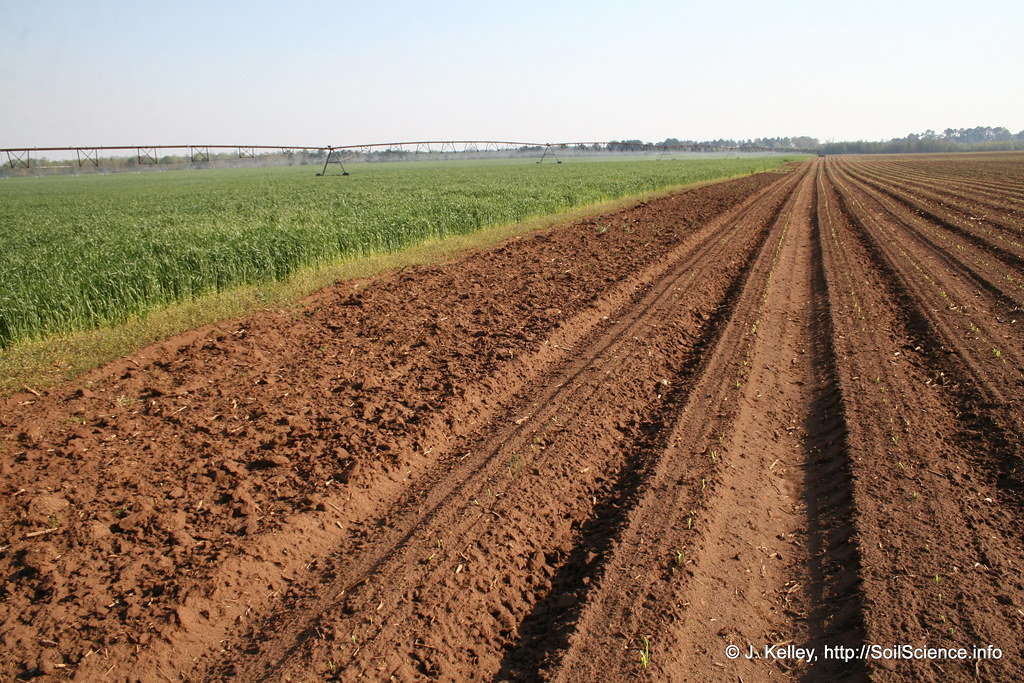
Typical agricultural soil (photo courtesy of Soil Science on Flickr) 
Healthy landscape soil (photo courtesy of Jim Downer)
Q: I like reusing cardboard packaging as part of organic weed control. Isn’t that a good enough reason to use cardboard?
A: In addition to interfering with water and gas movement into the soil environment, corrugated cardboard has chemical contaminants that you really don’t want in your soil or even your compost pile. Corrugated cardboard contains environmental contaminants including dioxin and PFAs or “forever chemicals.” No gardener should want to introduce more of these widespread contaminants into their landscape or garden soils.

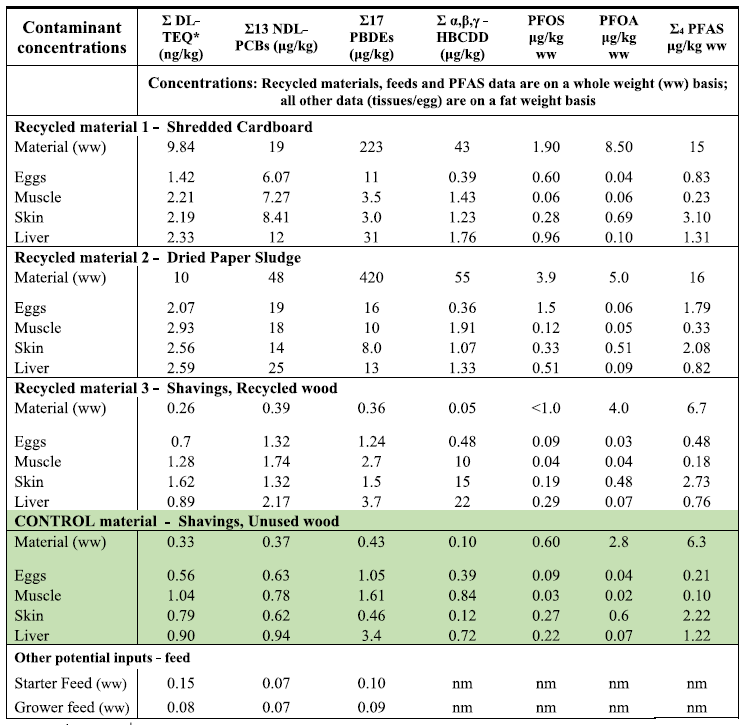
As I’ve been recommending for nearly a quarter century now, the very best mulch to use for treed landscapes is arborist wood chips. There is robust, peer-reviewed science establishing the benefits of arborist chip mulches in controlling weeds, enhancing growth and establishment of landscape plants, and maintaining a functional soil ecosystem. In contrast, sheet mulches such as plastic, weed fabric, and cardboard have demonstrated negative impacts on the long-term health of landscape soils. Any resource that says otherwise is not paying attention to the research-based facts.

Two questions…Has there been research, or do you know, how long after someone has sheet mulched an area that soil health begins to improve markedly? For instance, if it were covered with a tarp (as a neighbor has left in place for over a year!) How long would it take, if covered in arborist wood chips, for the soil to begin to host its macro and micro life?
Also, does your research on cardboard mulching as it affects soil health also apply to the rolls of paper mulch used for annual vegetable or flower gardening/production? Because of a lack of enough wood chips to kill off my grass in a large area, I am thinking of using that paper and then covering it with a lesser amount of chips, keeping the area mulched with chips over the long term as I plant into it. Thank you.
As I stated in the blog, there is no research on sheet mulches used on landscape soils. There is substantial work on the benefits of arborist wood chips to soil health. All you need to do is search the blog.
There is no sheet mulch that is appropriate for ladnscape soils. All sheet mulches will restrict gas movement more than a coarse, chunky mulch. Skip the paper – who knows what chemicals are used in processing? – and just use the chips.
I see an important definition of cardboard in this discussion. Are you referring to plasterboard which is chemical laden with glues or ordinary cardboard like used to make shoe boxes? What about how it is used? Cardboard breaks down quickly especially when combined with worm and their castings. It certainly is correct to say there is inadequate research. Defining terms are lacking here.
Read the article. They use commercially available poultry bedding, which is recycled, shredded, corrugated cardboard.
Check out chipdrop.com for Woodchips. That is a way to get enough Woodchips to kill off your grass area. It is $20 for up to a 15yrd. Load.
In large parts of this country, chipdrop is a pipe dream. I was on chipdrop for 3 1/2 years here in eastern NC with no success, finally got chips from one local arborist after reaching out to at least a dozen in my area. I agree that cardboard as mulch has serious concerns, but here, most people weed with glyphosate spray instead: going from bad to worse.
The contamination is really quite disappointing. Do you know why all those persistent chemicals end up in it? I’ve always ignorantly pictured the manufacturing process as simple because of how raw the product seems.
It’s the processing of wood pulp to make it resistant to water and/or other environmental degradation. Much of this information is not readily available. While I did a post doc in forest product chemistry, I was not involved with the pulping/processing side of things. I don’t know all the chemicals involved in making paper products.
Greg, Old corrugated containers, also known as OCC, are used cardboard materials. Old corrugated containers include everything from cardboard shipping boxes to pizza boxes. Cardboard is the most recycled packaging material in the U.S.
More than 93% of OCC was recycled in 2022 – and increase from 2021, and overall, a three-year average of 91.3%.https://www.afandpa.org/news/2023/how-does-afpa-calculate-paper-and-cardboard-recycling-rates#:~:text=The%20rate%20has%20followed%20a,or%20exceeded%2082%25%20since%202009.
I’m down in Miami, where our soil is poor for veggie gardening, so EVERYBODY uses a layer of cardboard at the bottom of their raised beds before layering wood/compost and then soil. Even at our extension office they recommend cardboard or newspaper to line the bottom of a bed. If it’s under the growing surface, suppresses weeds, and helps with water retention, how bad is it? It breaks down within a year in our climate.
You can choose to use science-based information or not. There are alternatives as this blog has discussed for 15 years.
Dioxins are formed when paper is bleached with chlorine. Since most cardboard is brown and unbleached there are no significant amount of dioxins in it. I got a degree in paper engineering from WMU
The table I shared in this post reports levels of polychlorinated dibenzo-p-dioxins and dibenzofurans (PCDD/Fs, dioxins) and polybrominated dioxins (PBDD/Fs) in bedding materials.
I suggest you read the actual paper.
What exactly are arborist chips?
Thanks
If you search this blog for “arborist wood chips” or “arborist chips” you’ll find all the posts we’ve done about them in the past. They are ground up wood from branch and tree removal by arborists.
Long time vegetable gardener (60 yrs) and also worked in the paper / cardboard industry for 10 years. Years ago when I first started seeing gardeners use cardboard in their gardens I cringed. Just seeing and smelling all of the chemicals that go into the production was more than enough reason to avoid it. Thanks for spreading the word.
I left a couple questions on the other blog for you before I found this update. I keep thinking of things to ask you! Do you put up a temporary barrier next to patios, pathways, etc. to hold back the 8-12 inches of wood chips? I need something easy. I have a lot of patios, stone stairs, walkways, etc. that I don’t want buried by wood chips or have a significant amount of chips falling on them. Is there any depth of wood chips that would actually smother/kill English ivy (if it was cut low to the ground)? I’m also in the Seattle area. I’m so disgusted by all the ivy around here. I’m so tired of battling it. I’m surrounded by it and also have a steep embankment with 50 year old ivy.
Ivy is a tough one. Scalping and applying an herbicide, a shrub killer might work the best, to the main stems is the best place to start.
You’ll need at least 12″ of chips to start the smothering process and it will take a season or two to accomplish. Spot treat with herbicide any ivy that grows through or around the mulch.
If you’re a member of the Garden Professors blog group on Facebook this topic has been discussed many times.
Use a barrier as needed to hold the chips in place. It might help keep the ivy from creeping out from under the chips too.
I am curious if the chemicals listed are from what I call “plastic cardboard” – rather than the typical plain brown cardboard? This is the stuff that has a shiny layer, often with colorful pictures.
You can go onto Google and search for images of cardboard poultry bedding. It is shredded corrugated cardboard.
Do you know if the authors of the paper were using plain brown corrugated cardboard only or were they including this “plastic cardboard”?
I don’t know what plastic cardboard is. If you read the article itself it tells you they used commercially available cardboard bedding, which is recycled, shredded, corrugated cardboard. You can easily find it on Google along with images.
Or all wood chips can be treated equally.
Any arborist wood chips that you can get work well. Bark is not the same thing and will not perform as well as wood chips.
I want to add another pollinator garden in my yard. The last one I started by breaking up the sod where the garden was planned. I just loosened it up. Then I placed a layer of brown grocery bags over it and topped it with about 10″ of quality soil, and four inches of wood chip mulch.
Is this safe, or do grocery bags have the same problems as cardboard? It worked fabulously, and the original garden is five years old with zero grass in the garden.
Please read all this blog on sheet mulches. You are smothering the soil (and the life it contains) with this proccess. Imagine lying on the ground and trying to breathe through the bags and soil covering your face. Just use the wood chips.
I have heard that you must leave arborist chips sit for a year before spreading into gardens. Is this true?
No, you can use them right away.
I am putting a 10 by 10 flagstone patio under a Doug fir tree. I had planned to use landscape fabric under the base of 1/4 minus gravel. I am using gravel between the flagstone to allow water into the root zone of the tree. I thought I would need the landscape material ad a weed barier, but after reading this article, it sounds that it would be detrimental to the root zone of the tree beyond the impact of my flagstone pieces.
Yes, the weed barrier will be detrimental for the roots.
The table from Fernandes et al. (2023) comparing the levels of contaminants between shredded cardboard and untreated wood shavings is indeed distressing. Level of PFAS in shredded cardboard is more than twice the level in untreated wood chips, and the difference is many times greater for all the other toxins shown.
What is most striking to me, however, is that all these toxins are found in untreated wood chips. This leads me to conclude that while we may take steps to minimize exposure to such poisons, they are inescapable. They are everywhere and are persistent.
Recycling corrugated and other cardboards seems the best way to keep the toxins they contain out of our landscapes. Better yet would be to require producers to not use these chemicals in the first place.
Many vemiculture casting producers use cardboard. Does your research include their products as well? If so, what referces would you cite?
I did a quick literature search and found no research on this question. However, vermicomposting uses cardboard and there’s no reason to think that the PFAs and other toxic chemicals taken up would not be bioaccumulated in earthworms just as they are in chickens.
This was stated in an article on bioaccumulation of PFAs in earthworms. “The results indicate that PFAA bioaccumulation into earthworms depends on soil concentrations, soil characteristics, analyte, and duration of exposure, and that accumulation into earthworms may be a potential route of entry of PFAAs into terrestrial foodwebs.” Reference at https://pubs.acs.org/doi/abs/10.1021/es504152d
I’ve been a certified composter in Texas for over 20 years and vermicompost at home. I do NOT use cardboard, I use shredded paper with soy inks. I hav red wrigglers and brown nose compost worms.
Great data, it makes more sense to me now. Thanks for putting science to it.
So what do I do now if I’ve used cardboard already and put mulch on top of it? It’s been several months, do I dig it up? If it’s already decomposed, is my soil ruined? Will it recover if I just use wood chips from now on?
I would just leave it there and only use wood chips from now on. Soil is not going to recover quickly from forever chemicals but they will disperse through the soil systems for a lower overall concentration. Not great, but now you know.
Thanks for the reply. It’s good thing that I didn’t put a lot down yet then. Now I know.
I’m guessing that the boxes 6-packs of beer come in are full of forever chemicals. They aren’t recyclable in my area of Michigan, so I was using them as pots. I also used rolled paper pots, but paper is recyclable. I do use a lot of cow pots and I’ve purchased some recycled wood pots which are peat free. Frankly, my nursery hasn’t made a profit yet, and now I’m going to have to spend more money on pots, but I appreciate your work. I’d hate to have helped spread forever chemicals about.
I’d love it if you could point me to information on whether using plastic pots is better than using recycled/repurposed pots. Plastic pots can be reused, but regathering them from customers isn’t easy, and I worry about phthalates, and things like root shock. I’m sure that beer boxes are probably better in a landfill than decomposing in flower gardens across the land.
I did find an Oregon State U extension service article from 2006 which said coir is sustainable, but I’ve read some articles since then that contend this is incorrect.
Sorry for the ramble. I’d appreciate some guidance on pots. I’m going to recycle about 3,000 paper pots, and throw out hundreds of beer boxes, and I’d like to adapt a new pot material that isn’t going to cause harm, and that might do some good.
Thanks for doing the science. I did look into the advisability of repurposing trash to use as planters, and I didn’t find much until I came across this article. I had my doubts. Now I know.
Coir is sustainable, it’s a by-product of coconut processing.
We don’t offer advise or suggestions for businesses.
I get not using cardboard as a base to mulch, but what about in situations of killing off grass and heavy weed pressure. Much of what I’ve seen puts cardboard over remanent grasses then covered in arborist mulch to kill the grass and weeds more so than feed the soil.
This topic has been discussed many times on the blog. A layer of 12″ of arborist wood chips on top of mown grass or weeds will restrict light but not water and oxygen. That’s what will kill weeds without negatively affecting the soil underneath.
Is there a soil-friendly way remove grass that requires less mulch, short of renting a sod cutter? I’m sure you’re right about the cardboard being a bad option, but you say 12″ of wood chips like it’s something you can just pop down to the store and get.
You can find arborist wood chips either from a tree service or from chipdrop.com. That is the most effective way of reducing light (and weeds) without impairing soil and root health. There is no similar product you can buy from a store.
Does this apply to newspaper as well?
What about those soft, brown, cardboard-ish containers that much fast food comes in? I’ve been ripping those up & putting them in my compost….
We just don’t know. This information, especially the PFAs info, is just starting to be studied. You can be sure that we will know before long.
PFAS are frequently found in “grease-proofed” cardboard and papers used for restaurant take out containers (and lots of food packaging in general). They don’t even need to feel waxy, like in the case of paper fries and cookie packages (think kids’ happy meal fries). Many restaurant chains, once aware, are taking steps to phase them out, but you can bet that they are in the cardboard you’ve put in your compost.
Here’s an article by Consumer Report that’s on point: https://www.consumerreports.org/health/food-contaminants/dangerous-pfas-chemicals-are-in-your-food-packaging-a3786252074/
Wow! I have a horrible invasive Bermuda grass problem everywhere a drop of water hits. There is no way to remove it. Local experts say only Roundup will kill it, but that is not an option for me. I thought I was being a better steward with the cardboard. Disappointing. I don’t think any amount of mulch alone will stop this stuff.
Yeah, anecdotally, in the South the weeds come regardless of mulch or even cardboard. Even 4-6″ of mulch in beds is insufficient in my area. And I don’t think 12″ of mulch is possible cost wise, plus it will run off in first first southern downpour. Weeding frequently is the only things that works. Don’t do chemicals, chemicals just destroys so much, is only temporarily effective, and the more hardy nasty weeds come back quickly and first.
You are correct. Weeds that grow from stolen such as Bermuda and Bindweed will eSily find their way through 12 inches of wood chips. There is a reason Roundup was created. I used it to kill off a lawn of Bermuda to start a garden. It took three applications over 6 months. But it was done. Grass never came back. Area is covered with three inches of wood chips which I renew.every year.
Cardboard will allow those stolens to poke through so it wouldn’t work anyway.
I have a pile of wood chips that the arborist left for me. Do I have to let it age before I use it around plants?
Nope, use it now or later, it doesn’t have to age.
What would be your recommended method for killing large swaths of lawn grass in order to restore native species afterward? (IE, a non-permanent way to kill the existing vegetation with the least long-term harm).
Cardboard has often been recommended for this as it can smother grass very quickly, and is less environmentally unfriendly than plastic tarp. Wood chips obviously would be very difficult to remove, and would have to be extremely thick to completely smother grass before it found its way through to light. Herbicides change the soil microbiome and run off into waterways – they’re usually considered a weapon of last resort against invasive species.
Which method do you professionally recommend as the most environmentally-friendly and practical?
Yes the chips have be very thick, 10″-12″ is recommended for instances such as yours.
Scalp the turf as close as possible and apply a deep layer of wood chips. Leave them in place to decompose. There’s no need to remove them to plant, just move them aside to expose the soil surface.
The correct application of the correct herbicide prior to laying down the chips will be a great help. The chips will help prevent runoff and help the soil micro-communites.
Hi – Thank you for this fascinating blog. I have a few follow-up questions/thoughts re weed barriers & sheet mulch materials.
1. Many websites that recommended plain brown cardboard as a weed barrier or sheet mulch material assure us that the glues are plant-based and safe. I was skeptical and kept searching for information. Your blog presents evidence that ANY cardboard (even a plain brown roll) contains nasty chemicals and smothers the soil organisms. Although plain brown cardboard is biodegradable (and therefore better than the horrid black plastic and synthetic landscape cloth that I keep finding all over my property), it is still not the optimal solution. Is this the correct take-away?
2. My project is replacing a lawn that is mostly crabgrass and replanting the area with native California species. Putting 12 inches of wood chips on my yard is not practical. I think 2-4 inches is more practical. Therefore, I continue to search for a weed barrier I can use OVER the crabgrass and UNDER the wood chips to help control the weeds.
3. I am experimenting with burlap (plain jute). It is permeable to air and water and, in combination with a layer of wood chips. helps block light and provides another physical barrier. I have started with two small sections of lawn: (A) has a layer of burlap plus wood chips and (B) has just wood chips. The wood chip layer on both sections is currently only 2 inches because I haven’t found a bulk source yet. So far, (A) is working much better than (B). Do you have thoughts on burlap?
Thank you.
1. Yes, you’re correct.
2. Use deep wood chips, 10″-12″ is recommended, to kill the weeds. 2″-4″ will do nothing. Better to use deep chips and no underlayment that will later interfere with replanting.
3.Burlap is non-biodegradable. It’s treated with waterproofing chemicals to resist rot. Plus weeds will grow through the burlap and be difficult to remove.
https://gardenprofessors.com/burlap-the-fashion-fabric-of-the-gardening-world/
A deep layer of wood chips is still your best option. Careful application of a carefully selected herbicide prior to applying wood chips will do a lot to help control the weeds. Also, be sure to scalp or mow the weeds closely before “chipping”.
What herbicide is recommended? I have a bermuda grass problem in a drought-tolerant yard that has fruit trees and I am trying to find a solution.
Hello! I have been reading your blog and extensively researching sheet mulching with cardboard – bad bad bad is the take away. Question for you, what are your thoughts of using soil to eradicate grass/weeds (at least 8 inches to a foot) followed by sowing a cover crop to prevent future weeds/grass? We are excavating our front yard to widen our driveway and will have a lot of soil leftover, instead of paying the exorbitant fee to get rid of this I thought could I just use this in my backyard to kills sections of grass instead of using cardboard? I don’t intend to plant in it for at least a year and it will be mostly perrenials. What are your thoughts or am I crazy? been trying to Google answers to this but nothing so far. TYIA.
Give it a try.
Carefully applying the correct herbicide before layering the soil might be helpful too.
Whatever cover crop you use mow it and leave in place when planting next year.
Thank you for your thoughtful examination of this issue.
I used some brown cardboard at the bottom of a 12 inch tall 4′ x 8′ raised bed to try and slow down some roots encroaching from surrounding shrubbery. Based on this research I won’t continue this practice, but I am wondering if the amount of chemicals in this cardboard is going to pose an immediate health risk from eating vegetables grown in this bed.
The cardboard has been in there since November and may be difficult to remove, but should I take all the soil out and try to remove all the pieces of cardboard?
How much of a human health risk is this?
Thank you for your time
Ideally it should be removed. It will also create drainage issues for the grow bed.
Depending on the form of the cardboard, e.g., big sheets or flattened boxes, you might be able to empty half of the bed and just pull or work the cardboard out. Or empty one half and just shift the growing medium over after you’ve removed the cardboard. You don’t have to completely empty the raised bed.
What are your thoughts regarding use of pine chips, or cedar chips in garden setting and for weed reduction. These are not bark chips, but are tree chips. Seem to be more uniform shapes than arborist chips, supplied by landscape shop in Salem area. Thank you
It depends on what those chips are made from. Are they really wood and not just bark? If so, they are fine. Not as good as arborist chips, because they are pretty inert for a while until they are hydrated and are colonized by fungi and fine roots.
Hello. I just watched you you tube video on the problems with sheet mulching. Just in time as i was about to pickup the cardboard for my turf removal. What are your thoughts on applying a layer of landscape compost before topping with 12 inches of arbirist chips? Would it speed up the decomposition process?
It depends. If this is an existing garden/landscape soil you don’t need the extra nutrients found in compost; it it is a bare, compacted soil, then an inch of compost can speed up soil recovery. Chips will create their own compost layer at the soil interface, so you never have to apply compost again.